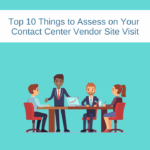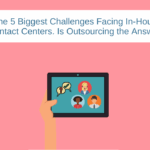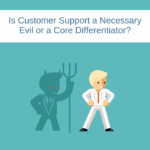What’s the True Cost of Your In-House Contact Center? (And How Does It Compare to Outsourcing?)

Too tired to read? Listen to the audio via our podcast here:
It’s a question we get asked a lot, and it’s one of the hardest ones to answer because it’s rare and challenging to determine a true apples-to-apples comparison, especially when there are intangible impacts like damage to brand when things go sideways.
That said, we know you’re trying to make a business case here, and the hard numbers do matter after all. So, we’ll take a comprehensive look at the cost of ownership of your in-house contact center – both intangible and tangible expenses – and how it compares to the cost of outsourcing.
The Cost of Human Capital
Though there are several types of pricing models for an outsourced contact center (check out Blue Ocean’s pricing models here,) it’s likely that many estimates you’ll receive in the process of evaluating potential partners will show a “per agent hour” number. If you’ve never outsourced before, it’s tempting to look at that number and think, well, we can hire contact center agents at a much cheaper rate than that!
Yes, you can. But the truth is that an “agent hour” encompasses much more than basic labor costs – and compensation is only the beginning.
And that beginning is this – PayScale cites an average $16/hour for a customer service rep. Of course, average wages for a contact center worker vary greatly depending on your geographic region, your industry, and your required skills and experiences, which is why Payscale also gives a range of $11 to $21 (USD) for the same position.
If you’re headquartered in a major metropolitan center, you’ll quickly find that not only are wages usually much higher than the median, but it’s also just plain hard to find people without looking in the suburbs where it’s more affordable for the types of workers you’re looking for to live – and many of them won’t be willing to commute into the city every day.
But, like we said, wages are just the start. You also need to consider the cost of taxes and benefits, which, according to the Bureau of Labor Statistics, together add up to over 30% of total compensation. So even assuming you can access agents at the median rate, your loaded rate becomes almost $23 an hour (USD).
Additionally, you need managers, supervisors, coaches, and trainers to manage your frontline agents, not to mention the extra HR time and financial investment in supporting them. That includes the tools and resources required for each of these roles to properly function, like training programs, project management tools, licenses, talent acquisition platforms/subscriptions, agent workstation and equipment costs, the IT support for your frontline, and much more.
Each of those elements adds up quickly in terms of cost. However, returning to the “per agent hour” (or sometimes “per minute” or “per transaction”) investment in a customer care outsourcer, every factor is already included.
The Cost of Contact Center Infrastructure
Next, let’s look at the physical space that is home to your contact center. In today’s environment, many organizations are leaning toward a hybrid model – so, unless you are a fully remote company, space equals expense. Again, the cost of this varies wildly depending on your locale, but average rent per square foot for metropolitan offices is $38, and that number is ever-growing. Plus, rent is only one piece of the puzzle – don’t overlook the cost of maintaining, heating, cooling, lighting, and furnishing the place.
And then there’s the technical infrastructure. Though technology has grown progressively cheaper over the years, the number of technical elements needed to support each contact center agent has actually increased. Once upon a time, agents simply had a phone. Today, they’re attached to their computers, working with contact center software that combines call distribution with a range of other integrated features, such as a CRM, IVR, call recording, and data analytics. Price per seat quickly adds up.
As noted, even if your solution leverages work-from-home agents, forgoing the need for physical office space, this doesn’t entirely dissipate the cost. Those agents still need the computer hardware, software licenses, telephony, and access to backup servers. (And management, HR, and IT support as mentioned in the paragraph above…)
Remember that “per agent hour” number for an outsourced partner? That number once again encompasses all these expenses – and the right partner is also strategically positioned to evolve their technical infrastructure as trends and emerging technologies come into the picture.
The Cost of Attrition and Retention
Here’s another somewhat intangible cost that’s no less important.
Employee engagement is critical for retention. Its success is the result of innovative management and HR leaders as well as tangible initiatives that ensure every employee is engaged in their work. So, you’re looking at the cost of the small, simple things, the cultural touchstones your employees value – holiday celebrations, recognition programs, etc. – as well as the bigger ticket items like career development opportunities – training programs, certifications, tuition reimbursements, etc.
If retention and employee engagement efforts fall out of the picture, there’s an even greater cost – that of attrition. A Gallup survey revealed that companies with reportedly low engagement had 35% to 75% higher turnover than those with high engagement. Considering that the cost of replacing an employee sits at around 16% of the position’s annual wages, the hit to your bottom line can be significant.
The right outsourced partner invests heavily in their retention efforts and employee engagement. They’re in tune with the implications of contact center attrition and place their employees first every time. And their investment in this area is, once again, fully loaded into their pricing model.
Total Cost of Ownership of an In-House Contact Center
Sure, we might be a little biased when it comes to the advantages of outsourcing your customer care program – caring for your customers is what we at Blue Ocean do best. But the numbers don’t lie, and it’s almost always a better business case to outsource your growing contact center. From the cost of people and the tools they need to the expense of your facility and supporting initiatives, every individual line item adds up and puts a heavy weight on your shoulders. That’s not to mention the intangible but most important cost you’ll experience when you take your eye off the ball and get into the weeds instead of focusing on your core competency as a business.
Need more proof? Get the hard numbers by requesting a pricing estimate today.
Read this next:
Why Asking for Contact Center Pricing Shouldn’t Be Your First Question
Overcoming the Expense of Customer Service in Major Urban Centers




